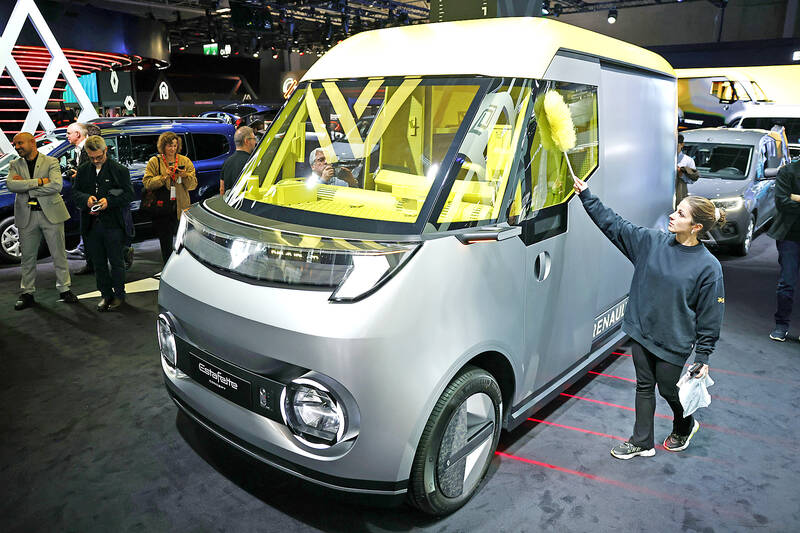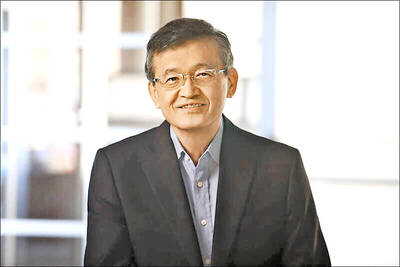Auto manufacturers competing to persuade drivers to go electric are rolling out cheaper, more tech-rich models at the Paris Motor Show, targeting everyone from luxury clients to students yet to receive their driving licenses.
The biennial show has long been a major industry showcase, tracing its history to 1898.
Chinese manufacturers are attending in force, despite European Union threats to punitively tax imports of their electric vehicles (EVs) in a brewing trade war with Beijing. Long-established European manufacturers are fighting back with new efforts to win consumers who have balked at high-priced EVs.

Photo: Yoan Valat, EPA-EFE
More new models from China
Chinese EV start-ups Leapmotor Technologies Ltd (零跑) and XPeng Inc (小鵬) showcased models they said incorporate artificial intelligence (AI) technology.
Leapmotor, founded in 2015, unveiled a compact electric-powered SUV, the B10. It will be manufactured in Poland for European buyers, Leapmotor product planning head Zhong Tianyue (鍾天樂) said. Leapmotor didn't announce a price for the B10 that will launch next year.
Leapmotor also said a smaller electric commuter car it showcased in Paris, the T03, will retail from a competitive 18,900 euros (US$20,620). Those sold in France will be imported from China but assembled in Poland, Zhong said.
Leapmotor also announced a starting price of 36,400 euros (US$39,700) in Europe for its larger family car, the C10.
Sales outside of China are through a joint venture with Stellantis NV, the world’s fourth-largest carmaker. Leapmotor said European sales started last month.
XPeng braces for tariff hit
Attending the Paris show for the first time, the decade-old Chinese EV manufacturer XPeng unveiled a sleek sedan, the P7+.
CEO He Xiaopeng (何小鵬) said XPeng aims to deliver in Europe from next year. Intended European prices for the P7+ weren't given, but He said they will start in China at 209,800 yuan, the equivalent of 27,100 euros, or US$29,600.
XPeng president Brian Gu (顧宏地) said the EU's threatened import duties could complicate the company's expansion plans if Brussels and Beijing don't find an amicable solution to their trade dispute before an end-of-October deadline.
Brussels says subsidies help Chinese companies to unfairly undercut EU industry prices, with Chinese-built electric cars jumping from 3.9 percent of the EV market in 2020 to 25 percent by September last year.
“The tariff will put a lot of pressure on our business model. It's a direct hit on our margin, which is already not very high," Gu said.
Vehicles for young teens
Manufacturers of small EVs that can be driven in Europe without a license are finding a growing market among teens as young as 14 and their parents who, for safety reasons, prefer that they zip around on four wheels than on motorbikes.
Several manufacturers of the two-seaters are showcasing in Paris, including France's Citroen. The starting price for its Ami, or “Friend,” is just under 8,000 euros (US$8,720). Launched in France in 2020, the plastic-shelled vehicle is now also sold in other European markets and in Turkey, Morocco and South America.
“It's not a car. It's a mobility object,” Citroen product chief Alain Le Gouguec said.
European legislation allows teenagers without a full license to drive the Ami and similar buggies from age 14 after an eight-hour training course. They're limited to a top speed of 45 kilometers per hour (28 mph).
The vehicles are also finding markets among adults who lost their license for driving infractions or who never got a full license, and outside cities in areas with poor transport.
Renault subsidiary Mobilize said that even in winter's energy-sapping cold its two-seater, no-license, plastic-shelled Duo can go 100 kilometers (over 60 miles) between charges. A phone app acts as its door and ignition key.
Another French manufacturer, Ligier, sells its no-license two-seaters in both diesel and electric versions.

Intel Corp chief executive officer Lip-Bu Tan (陳立武) is expected to meet with Taiwanese suppliers next month in conjunction with the opening of the Computex Taipei trade show, supply chain sources said on Monday. The visit, the first for Tan to Taiwan since assuming his new post last month, would be aimed at enhancing Intel’s ties with suppliers in Taiwan as he attempts to help turn around the struggling US chipmaker, the sources said. Tan is to hold a banquet to celebrate Intel’s 40-year presence in Taiwan before Computex opens on May 20 and invite dozens of Taiwanese suppliers to exchange views

Application-specific integrated circuit designer Faraday Technology Corp (智原) yesterday said that although revenue this quarter would decline 30 percent from last quarter, it retained its full-year forecast of revenue growth of 100 percent. The company attributed the quarterly drop to a slowdown in customers’ production of chips using Faraday’s advanced packaging technology. The company is still confident about its revenue growth this year, given its strong “design-win” — or the projects it won to help customers design their chips, Faraday president Steve Wang (王國雍) told an online earnings conference. “The design-win this year is better than we expected. We believe we will win

Chizuko Kimura has become the first female sushi chef in the world to win a Michelin star, fulfilling a promise she made to her dying husband to continue his legacy. The 54-year-old Japanese chef regained the Michelin star her late husband, Shunei Kimura, won three years ago for their Sushi Shunei restaurant in Paris. For Shunei Kimura, the star was a dream come true. However, the joy was short-lived. He died from cancer just three months later in June 2022. He was 65. The following year, the restaurant in the heart of Montmartre lost its star rating. Chizuko Kimura insisted that the new star is still down

While China’s leaders use their economic and political might to fight US President Donald Trump’s trade war “to the end,” its army of social media soldiers are embarking on a more humorous campaign online. Trump’s tariff blitz has seen Washington and Beijing impose eye-watering duties on imports from the other, fanning a standoff between the economic superpowers that has sparked global recession fears and sent markets into a tailspin. Trump says his policy is a response to years of being “ripped off” by other countries and aims to bring manufacturing to the US, forcing companies to employ US workers. However, China’s online warriors